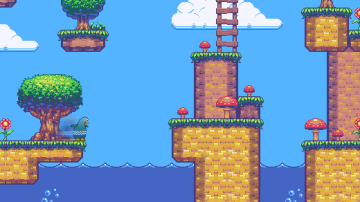In the previous article in this series, you simulated gravity, but now you need to give your player a way to fight against gravity by jumping.
A jump is a temporary reprieve from gravity. For a few moments, you jump up instead of falling down, the way gravity is pulling you. But once you hit the peak of your jump, gravity kicks in again and pulls you back down to earth.
In code, this translates to variables. First, you must establish variables for the player sprite so that Python can track whether or not the sprite is jumping. Once the player sprite is jumping, then gravity is applied to the player sprite again, pulling it back down to the nearest object.
Setting jump state variables
You must add two new variables to your Player class:
- One to track whether your player is jumping or not, determined by whether or not your player sprite is standing on solid ground
- One to bring the player back down to the ground
Add these variables to your Player class. In the following code, the lines above the comment are for context, so just add the final two lines:
self.frame = 0
self.health = 10
# jump code below
self.is_jumping = True
self.is_falling = FalseThese new values are called Boolean values, which is a term (named after mathematician George Boole) meaning either true or false. In programming, this is a special data type indicating that a variable is either "on" or "off". In this case, the hero sprite can either be falling or not falling, and it can be jumping or not jumping.
The first variable (is_jumping) is set to True because I'm spawing the hero in the sky and need it to fall immediately to the ground, as if it were in mid-jump. This is a little counter-intuitive, because the hero isn't actually jumping. The hero has only just spawned. This is theoretically an abuse of this Boolean value, and it is admittedly "cleaner" code to have True and False statements that actually reflect reality. However, I find it easier to let gravity help the hero find the ground rather than having to hard code a spawn position every level. It also evokes classic platformers, and gives the player the sense of "jumping into" the game world. In other words, this is a small initial lie that serves the program, so set it to True.
The other variable (is_falling) is also set to True because the hero does indeed need to descend to the ground.
Conditional gravity
In the real world, jumping is an act of moving against gravity. In your game, though, gravity only needs to be "on" when the hero sprite isn't standing on solid ground. When you have gravity on all the time (in Pygame), you risk getting a bounce-effect on your hero sprite as gravity constantly tries to force the hero down while the collision with the ground resists. Not all game engines require this much interaction with gravity, but Pygame isn't designed exclusively for platformers (you could write a top-down game instead, for example) so gravity isn't managed by the engine.
Your code is only emulating gravity in your game world. The hero sprite isn't actually falling when it appears to fall, it's being moved by your gravity function. To permit your hero sprite to fight gravity and jump, or to collide with solid objects (like the ground and floating platforms), you must modify your gravity function to activate only when the hero is jumping. This code replaces the entire gravity function you wrote for the previous article:
def gravity(self):
if self.is_jumping:
self.movey += 3.2This causes your hero sprite to fall right through the bottom of the screen, but you can fix that with some collision detection on the ground.
Programming solid ground
In the previous article, a quick hack was implemented to keep the hero sprite from falling through the bottom of the screen. It kept the hero on screen, but only by creating an invisible wall across the bottom of the screen. It's cleaner to use objects as objects, and besides it's pretty common in platformers to allow players to fall off the world as a penalty for a poorly timed jump.
In the update function of your Player class, add this code:
ground_hit_list = pygame.sprite.spritecollide(self, ground_list, False)
for g in ground_hit_list:
self.movey = 0
self.rect.bottom = g.rect.top
self.is_jumping = False # stop jumping
# fall off the world
if self.rect.y > worldy:
self.health -=1
print(self.health)
self.rect.x = tx
self.rect.y = tyThis code block checks for collisions happening between ground sprites and the hero sprite. This is the same principle you used when detecting a hit against your hero by an enemy.
In the event of a collision, it uses builtin information provided by Pygame to find the bottom of the hero sprite (self.rect.bottom), and set its position to the top of the ground sprite (p.rect.top). This provides the illusion that the hero sprite is "standing" on the ground, and prevents it from falling through the ground.
It also sets self.is_falling to 0 so that the program is aware that the hero is not in mid-jump. Additionally, it sets self.movey to 0 so the hero is not pulled by gravity (it's a quirk of game physics that you don't need to continue to pull a sprite toward Earth once the sprite has been grounded).
The if statement at the end detects whether the player has descended below the level of the ground; if so, it deducts health points as a penalty, and then respawns the hero sprite back at the top left of the screen (using the values of tx and ty, the size of tiles. as quick and easy starting values.) This assumes that you want your player to lose health points and respawn for falling off the world. That's not strictly necessary; it's just a common convention in platformers.
Jumping in Pygame
The code to jump happens in several places. First, create a jump function to "flip" the is_jumping and is_falling values:
def jump(self):
if self.is_jumping is False:
self.is_falling = False
self.is_jumping = TrueThe actual lift-off from the jump action happens in the update function of your Player class:
if self.is_jumping and self.is_falling is False:
self.is_falling = True
self.movey -= 33 # how high to jumpThis code executes only when the is_jumping variable is True while the is_falling variable is False. When these conditions are satisfied, the hero sprite's Y position is adjusted to 33 pixels in the "air". It's negative 33 because a lower number on the Y axis in Pygame means it's closer to the top of the screen. That's effectively a jump. You can adjust the number of pixels for a lower or higher jump. This clause also sets is_falling to True, which prevents another jump from being registered. If you set it to False, a jump action would compound on itself, shooting your hero into space, which is fun to witness but not ideal for gameplay.
Calling the jump function
The problem is that nothing in your main loop is calling the jump function yet. You made a placeholder keypress for it early on, but right now, all the jump key does is print jump to the terminal.
In your main loop, change the result of the Up arrow from printing a debug statement to calling the jump function.
if event.key == pygame.K_UP or event.key == ord('w'):
player.jump()If you would rather use the Spacebar for jumping, set the key to pygame.K_SPACE instead of pygame.K_UP. Alternately, you can use both (as separate if statements) so that the player has a choice.
Landing on a platform
So far, you've defined an anti-gravity condition for when the player sprite hits the ground, but the game code keeps platforms and the ground in separate lists. (As with so many choices made in this article, that's not strictly necessary, and you can experiment with treating the ground as just another platform.) To enable a player sprite to stand on top of a platform, you must detect a collision between the player sprite and a platform sprite, and stop gravity from "pulling" it downward.
Place this code into your update function:
plat_hit_list = pygame.sprite.spritecollide(self, plat_list, False)
for p in plat_hit_list:
self.is_jumping = False # stop jumping
self.movey = 0
# approach from below
if self.rect.bottom <= p.rect.bottom:
self.rect.bottom = p.rect.top
else:
self.movey += 3.2This code scans through the list of platforms for any collisions with your hero sprite. If one is detected, then is_jumping is set to False and any movement in the sprite's Y position is cancelled.
Platforms hang in the air, meaning the player can interact with them by approaching them from either above or below. It's up to you how you want the platforms to react to your hero sprite, but it's not uncommon to block a sprite from accessing a platform from below. The code in the second code block treats platforms as a sort of ceiling or pergola, such that the hero can jump onto a platform as long as it jumps higher than the platform's topside, but obstructs the sprite when it tries to jump from beneath:
The first clause of the if statement detects whether the bottom of the hero sprite is less than (higher on the screen) than the platform. If it is, then the hero "lands" on the platform, because the value of the bottom of the hero sprite is made equal to the top of the platform sprite. Otherwise, the hero sprite's Y position is increased, causing it to "fall" away from the platform.
Falling
If you try your game now, you find that jumping works mostly as expected, but falling isn't consistent. For instance, after your hero jumps onto a platform, it can't walk off of a platform to fall to the ground. It just stays in the air, as if there was still a platform beneath it. However, you are able to cause the hero to jump off of a platform.
The reason for this is the way gravity has been implemented. Colliding with a platform turns gravity "off" so the hero sprite doesn't fall through the platform. The problem is, nothing turns gravity back on when the hero walks off the edge of a platform.
You can force gravity to reactivate by activating gravity during the hero sprite's movement. Edit the movement code in the update function of your Player class, adding a statement to activate gravity during movement. The two lines you need to add are commented:
if self.movex < 0:
self.is_jumping = True # turn gravity on
self.frame += 1
if self.frame > 3 * ani:
self.frame = 0
self.image = pygame.transform.flip(self.images[self.frame // ani], True, False)
if self.movex > 0:
self.is_jumping = True # turn gravity on
self.frame += 1
if self.frame > 3 * ani:
self.frame = 0
self.image = self.images[self.frame // ani]This activates gravity long enough to cause the hero sprite to fall to the ground upon a failed platform collision check.
Try your game now. Everything works as expected, but try changing some variables to see what's possible.
In the next article, you'll make your world scroll.
Here's all the code so far:
#!/usr/bin/env python3
# by Seth Kenlon
# GPLv3
# This program is free software: you can redistribute it and/or
# modify it under the terms of the GNU General Public License as
# published by the Free Software Foundation, either version 3 of the
# License, or (at your option) any later version.
#
# This program is distributed in the hope that it will be useful, but
# WITHOUT ANY WARRANTY; without even the implied warranty of
# MERCHANTABILITY or FITNESS FOR A PARTICULAR PURPOSE. See the GNU
# General Public License for more details.
#
# You should have received a copy of the GNU General Public License
# along with this program. If not, see <http://www.gnu.org/licenses/>.
import pygame
import sys
import os
'''
Variables
'''
worldx = 960
worldy = 720
fps = 40
ani = 4
world = pygame.display.set_mode([worldx, worldy])
BLUE = (25, 25, 200)
BLACK = (23, 23, 23)
WHITE = (254, 254, 254)
ALPHA = (0, 255, 0)
'''
Objects
'''
# x location, y location, img width, img height, img file
class Platform(pygame.sprite.Sprite):
def __init__(self, xloc, yloc, imgw, imgh, img):
pygame.sprite.Sprite.__init__(self)
self.image = pygame.image.load(os.path.join('images', img)).convert()
self.image.convert_alpha()
self.image.set_colorkey(ALPHA)
self.rect = self.image.get_rect()
self.rect.y = yloc
self.rect.x = xloc
class Player(pygame.sprite.Sprite):
"""
Spawn a player
"""
def __init__(self):
pygame.sprite.Sprite.__init__(self)
self.movex = 0
self.movey = 0
self.frame = 0
self.health = 10
self.is_jumping = True
self.is_falling = True
self.images = []
for i in range(1, 5):
img = pygame.image.load(os.path.join('images', 'hero' + str(i) + '.png')).convert()
img.convert_alpha()
img.set_colorkey(ALPHA)
self.images.append(img)
self.image = self.images[0]
self.rect = self.image.get_rect()
def gravity(self):
if self.is_jumping:
self.movey += 3.2
def control(self, x, y):
"""
control player movement
"""
self.movex += x
def jump(self):
if self.is_jumping is False:
self.is_falling = False
self.is_jumping = True
def update(self):
"""
Update sprite position
"""
# moving left
if self.movex < 0:
self.is_jumping = True
self.frame += 1
if self.frame > 3 * ani:
self.frame = 0
self.image = pygame.transform.flip(self.images[self.frame // ani], True, False)
# moving right
if self.movex > 0:
self.is_jumping = True
self.frame += 1
if self.frame > 3 * ani:
self.frame = 0
self.image = self.images[self.frame // ani]
# collisions
enemy_hit_list = pygame.sprite.spritecollide(self, enemy_list, False)
for enemy in enemy_hit_list:
self.health -= 1
# print(self.health)
ground_hit_list = pygame.sprite.spritecollide(self, ground_list, False)
for g in ground_hit_list:
self.movey = 0
self.rect.bottom = g.rect.top
self.is_jumping = False # stop jumping
# fall off the world
if self.rect.y > worldy:
self.health -=1
print(self.health)
self.rect.x = tx
self.rect.y = ty
plat_hit_list = pygame.sprite.spritecollide(self, plat_list, False)
for p in plat_hit_list:
self.is_jumping = False # stop jumping
self.movey = 0
if self.rect.bottom <= p.rect.bottom:
self.rect.bottom = p.rect.top
else:
self.movey += 3.2
if self.is_jumping and self.is_falling is False:
self.is_falling = True
self.movey -= 33 # how high to jump
self.rect.x += self.movex
self.rect.y += self.movey
class Enemy(pygame.sprite.Sprite):
"""
Spawn an enemy
"""
def __init__(self, x, y, img):
pygame.sprite.Sprite.__init__(self)
self.image = pygame.image.load(os.path.join('images', img))
self.image.convert_alpha()
self.image.set_colorkey(ALPHA)
self.rect = self.image.get_rect()
self.rect.x = x
self.rect.y = y
self.counter = 0
def move(self):
"""
enemy movement
"""
distance = 80
speed = 8
if self.counter >= 0 and self.counter <= distance:
self.rect.x += speed
elif self.counter >= distance and self.counter <= distance * 2:
self.rect.x -= speed
else:
self.counter = 0
self.counter += 1
class Level:
def ground(lvl, gloc, tx, ty):
ground_list = pygame.sprite.Group()
i = 0
if lvl == 1:
while i < len(gloc):
ground = Platform(gloc[i], worldy - ty, tx, ty, 'tile-ground.png')
ground_list.add(ground)
i = i + 1
if lvl == 2:
print("Level " + str(lvl))
return ground_list
def bad(lvl, eloc):
if lvl == 1:
enemy = Enemy(eloc[0], eloc[1], 'enemy.png')
enemy_list = pygame.sprite.Group()
enemy_list.add(enemy)
if lvl == 2:
print("Level " + str(lvl))
return enemy_list
# x location, y location, img width, img height, img file
def platform(lvl, tx, ty):
plat_list = pygame.sprite.Group()
ploc = []
i = 0
if lvl == 1:
ploc.append((200, worldy - ty - 128, 3))
ploc.append((300, worldy - ty - 256, 3))
ploc.append((550, worldy - ty - 128, 4))
while i < len(ploc):
j = 0
while j <= ploc[i][2]:
plat = Platform((ploc[i][0] + (j * tx)), ploc[i][1], tx, ty, 'tile.png')
plat_list.add(plat)
j = j + 1
print('run' + str(i) + str(ploc[i]))
i = i + 1
if lvl == 2:
print("Level " + str(lvl))
return plat_list
'''
Setup
'''
backdrop = pygame.image.load(os.path.join('images', 'stage.png'))
clock = pygame.time.Clock()
pygame.init()
backdropbox = world.get_rect()
main = True
player = Player() # spawn player
player.rect.x = 0 # go to x
player.rect.y = 30 # go to y
player_list = pygame.sprite.Group()
player_list.add(player)
steps = 10
eloc = []
eloc = [300, 0]
enemy_list = Level.bad(1, eloc)
gloc = []
tx = 64
ty = 64
i = 0
while i <= (worldx / tx) + tx:
gloc.append(i * tx)
i = i + 1
ground_list = Level.ground(1, gloc, tx, ty)
plat_list = Level.platform(1, tx, ty)
'''
Main Loop
'''
while main:
for event in pygame.event.get():
if event.type == pygame.QUIT:
pygame.quit()
try:
sys.exit()
finally:
main = False
if event.type == pygame.KEYDOWN:
if event.key == ord('q'):
pygame.quit()
try:
sys.exit()
finally:
main = False
if event.key == pygame.K_LEFT or event.key == ord('a'):
player.control(-steps, 0)
if event.key == pygame.K_RIGHT or event.key == ord('d'):
player.control(steps, 0)
if event.key == pygame.K_UP or event.key == ord('w'):
player.jump()
if event.type == pygame.KEYUP:
if event.key == pygame.K_LEFT or event.key == ord('a'):
player.control(steps, 0)
if event.key == pygame.K_RIGHT or event.key == ord('d'):
player.control(-steps, 0)
world.blit(backdrop, backdropbox)
player.update()
player.gravity()
player_list.draw(world)
enemy_list.draw(world)
ground_list.draw(world)
plat_list.draw(world)
for e in enemy_list:
e.move()
pygame.display.flip()
clock.tick(fps)
This is the 8th installment in an ongoing series about creating video games in Python 3 using the Pygame module. Previous articles are:
- Learn how to program in Python by building a simple dice game
- Build a game framework with Python using the Pygame module
- How to add a player to your Python game
- Using Pygame to move your game character around
- What's a hero without a villain? How to add one to your Python game
- Add platforms to your game
- Simulate gravity in your Python game











1 Comment